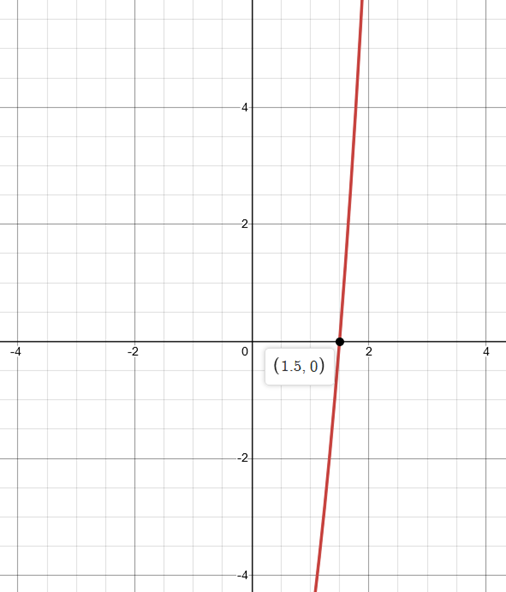
Concept explainers
a.
Find the zeros of the polynomial function
a.
Answer to Problem 41E
Explanation of Solution
Given:
Function:
Calculation:
The leading coefficient of given polynomial is 2 and the constant term is -12.
So, possible rational zeros are:
Using synthetic division to check whether
Here, remainder is 0. So,
So,
Now, consider
The above polynomial function is a second degree polynomial.
So, zeroes of a second degree polynomial can be found using the formula
Conclusion:
Therefore, the zeros of given polynomial function are
b.
Write the zeros of polynomial
b.
Answer to Problem 41E
Explanation of Solution
Given:
Function:
Calculation:
From above answer, the zeros of given function are
Now, writing the given function as product of linear factors,
c.
Determine the x-intercepts of polynomial
c.
Answer to Problem 41E
1
Explanation of Solution
Given:
Function:
Calculation:
Factorization of given function is
To find x-intercepts, put
Hence, the x-intercepts are
Calculation for graph:
Consider
| Values of x | Values of f (x) |
| 0 | -12 |
| 1 | -5 |
| -1 | -25 |
| 2 | 8 |
| -2 | -56 |
By taking different values of x, the graph can be plotted.
Graph:
Interpretation:
From graph, it is clear that, the number of x-intercepts is equal to 1.
The number of real zeros of the function is equal to 1.
So, the number of real zeros and number of x-intercepts are equal to each other.
Chapter 2 Solutions
EP PRECALC.GRAPHING APPR.-WEBASSIGN-1YR
- Force with 800 N and 400 N are acting on a machine part at 30° and 60°, respectively with a positive x axis, Draw the diagram representing this situationarrow_forwardI forgot to mention to you to solve question 1 and 2. Can you solve it using all data that given in the pict i given and can you teach me about that.arrow_forwardexam review please help!arrow_forward
 Calculus: Early TranscendentalsCalculusISBN:9781285741550Author:James StewartPublisher:Cengage Learning
Calculus: Early TranscendentalsCalculusISBN:9781285741550Author:James StewartPublisher:Cengage Learning Thomas' Calculus (14th Edition)CalculusISBN:9780134438986Author:Joel R. Hass, Christopher E. Heil, Maurice D. WeirPublisher:PEARSON
Thomas' Calculus (14th Edition)CalculusISBN:9780134438986Author:Joel R. Hass, Christopher E. Heil, Maurice D. WeirPublisher:PEARSON Calculus: Early Transcendentals (3rd Edition)CalculusISBN:9780134763644Author:William L. Briggs, Lyle Cochran, Bernard Gillett, Eric SchulzPublisher:PEARSON
Calculus: Early Transcendentals (3rd Edition)CalculusISBN:9780134763644Author:William L. Briggs, Lyle Cochran, Bernard Gillett, Eric SchulzPublisher:PEARSON Calculus: Early TranscendentalsCalculusISBN:9781319050740Author:Jon Rogawski, Colin Adams, Robert FranzosaPublisher:W. H. Freeman
Calculus: Early TranscendentalsCalculusISBN:9781319050740Author:Jon Rogawski, Colin Adams, Robert FranzosaPublisher:W. H. Freeman
 Calculus: Early Transcendental FunctionsCalculusISBN:9781337552516Author:Ron Larson, Bruce H. EdwardsPublisher:Cengage Learning
Calculus: Early Transcendental FunctionsCalculusISBN:9781337552516Author:Ron Larson, Bruce H. EdwardsPublisher:Cengage Learning





